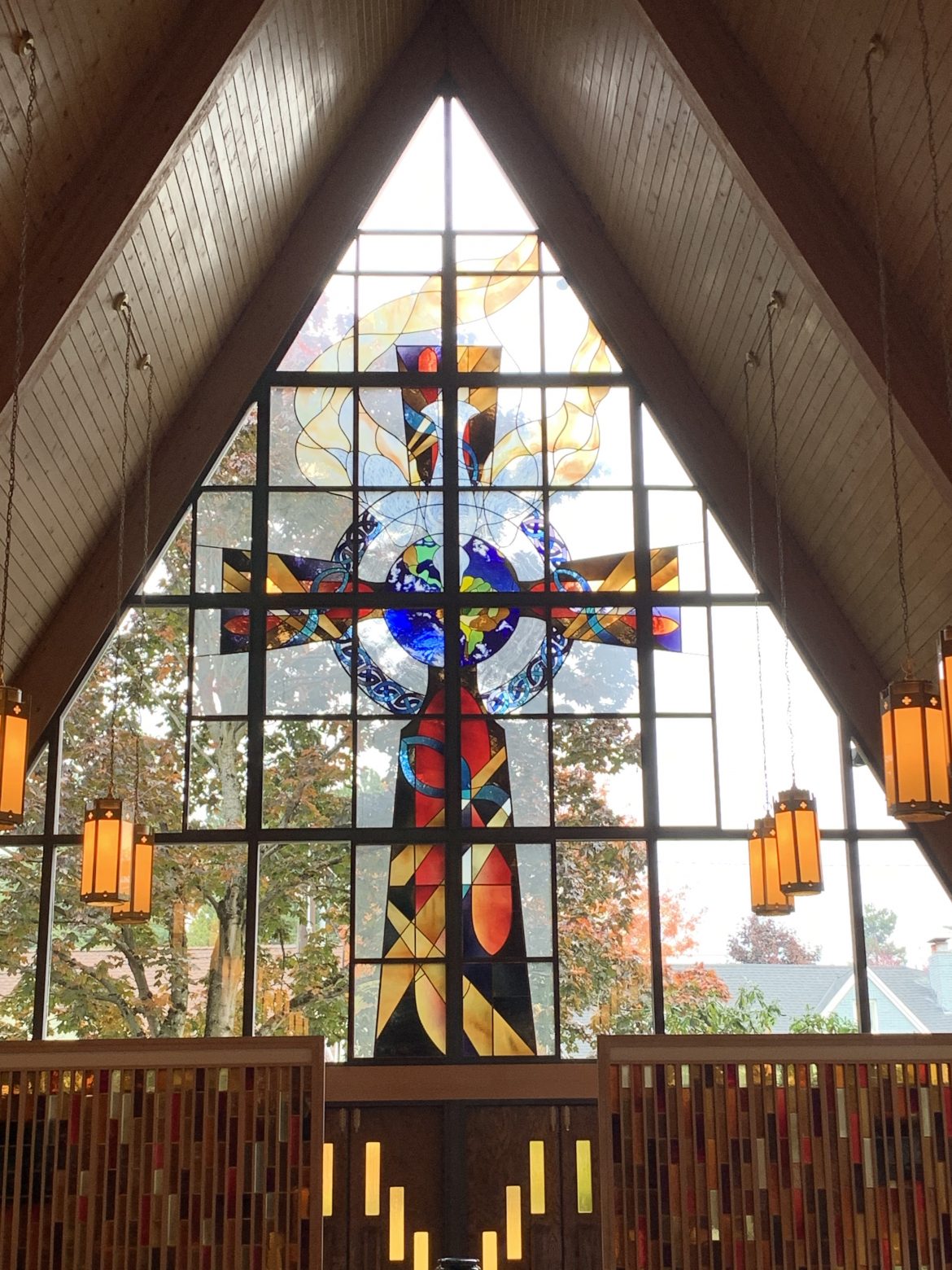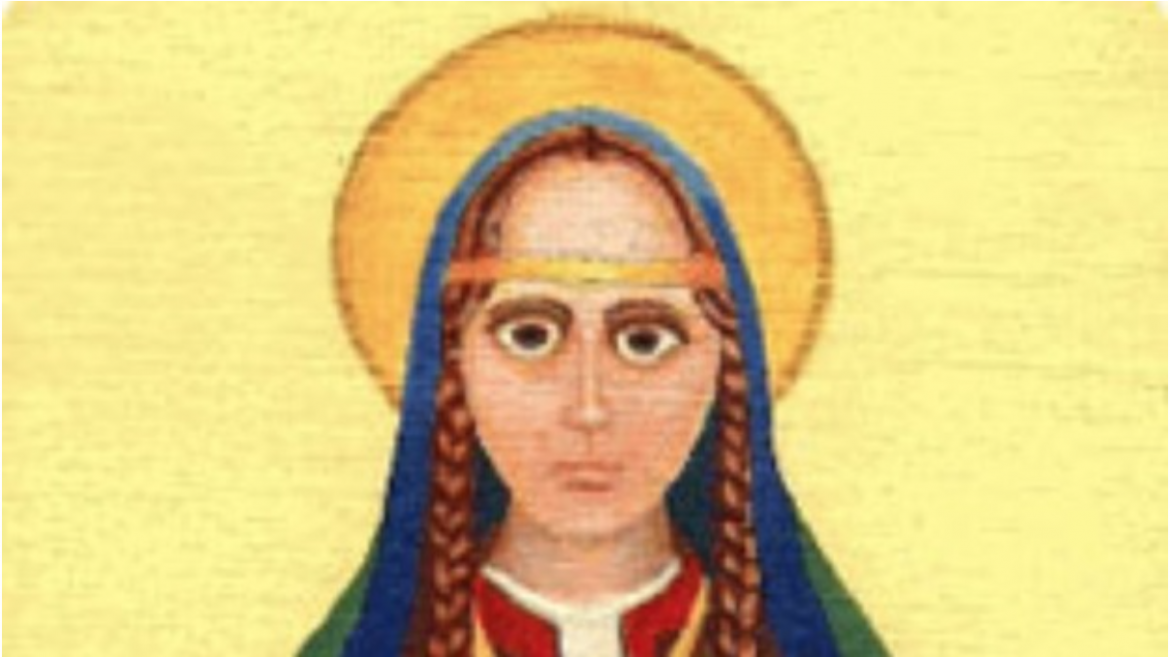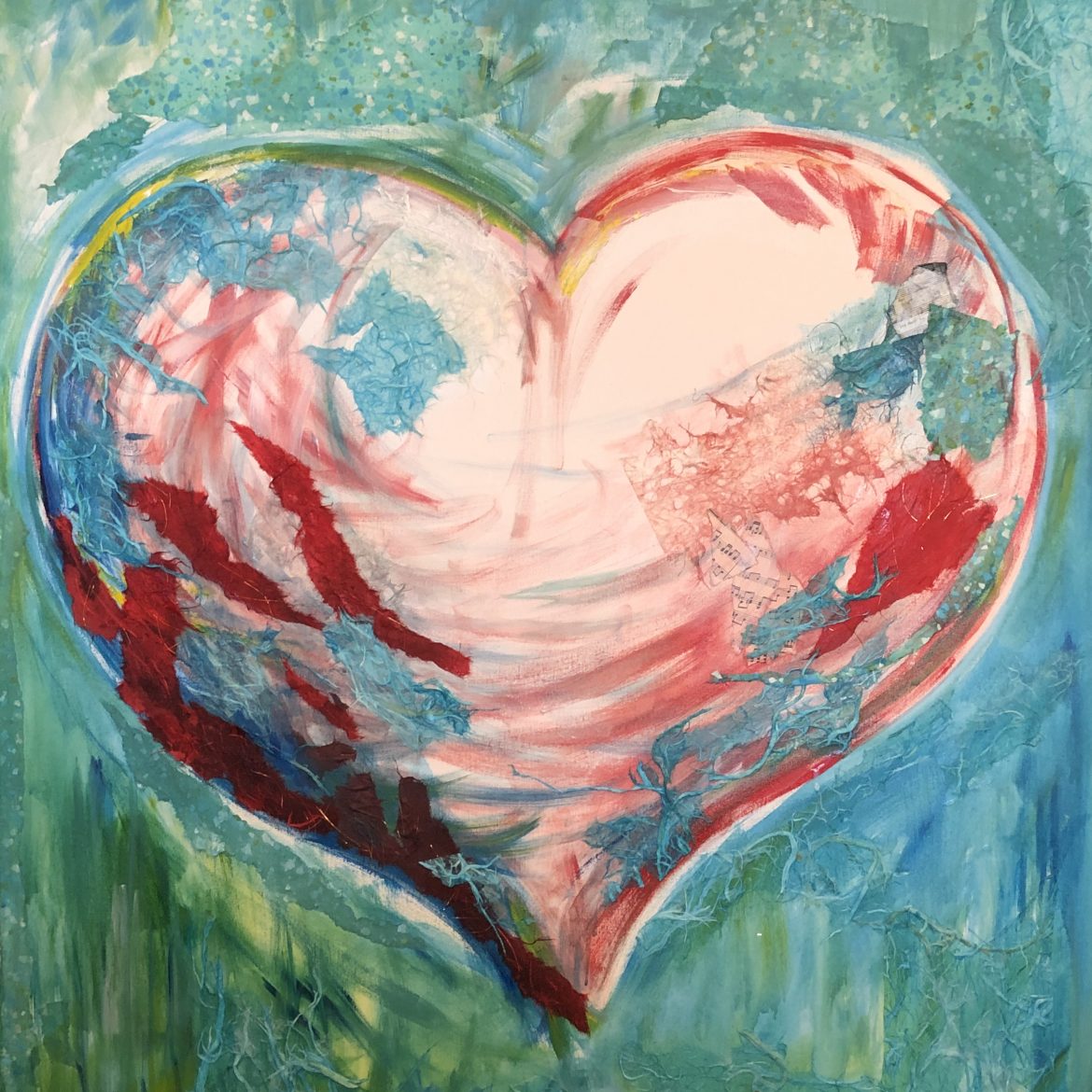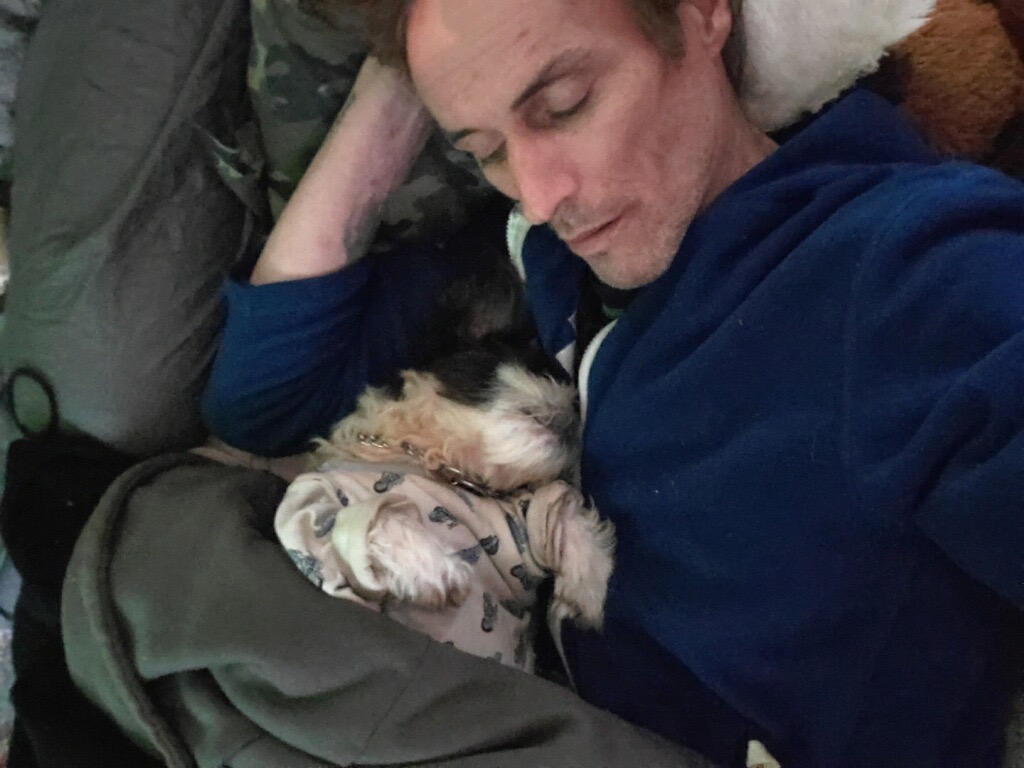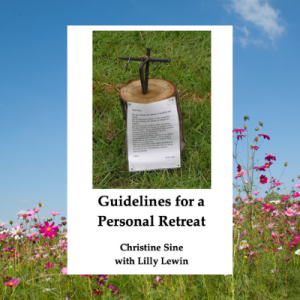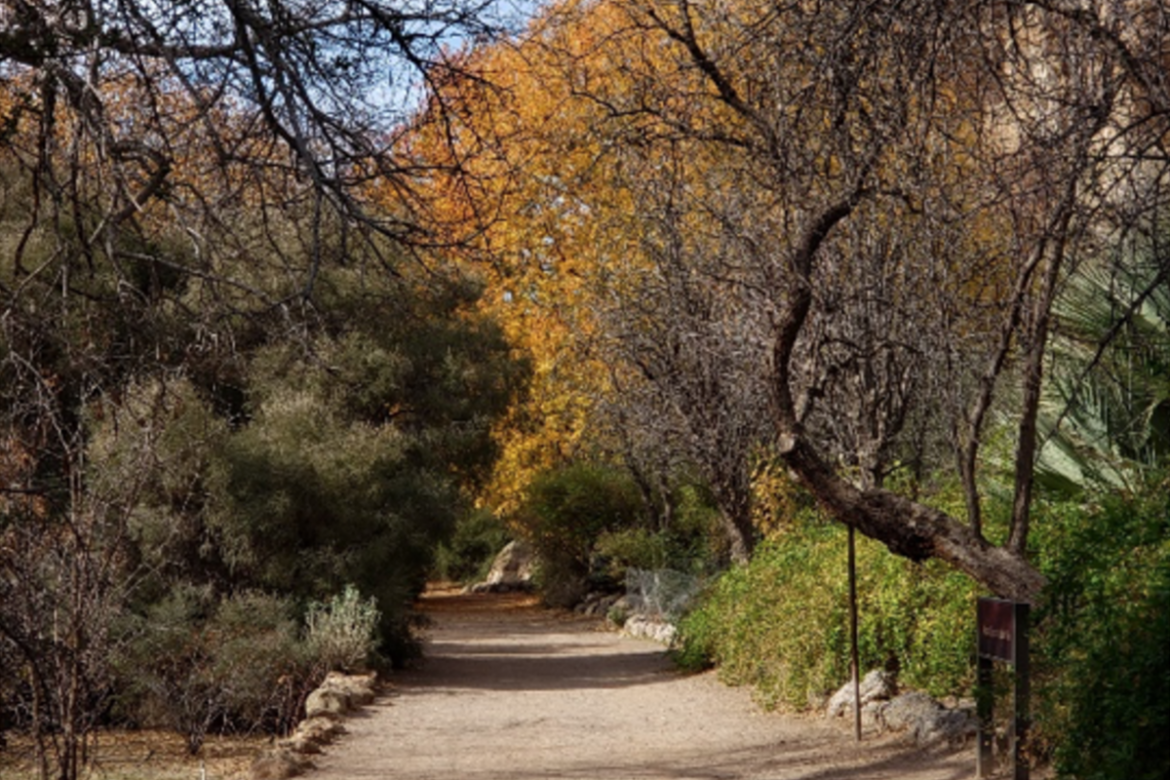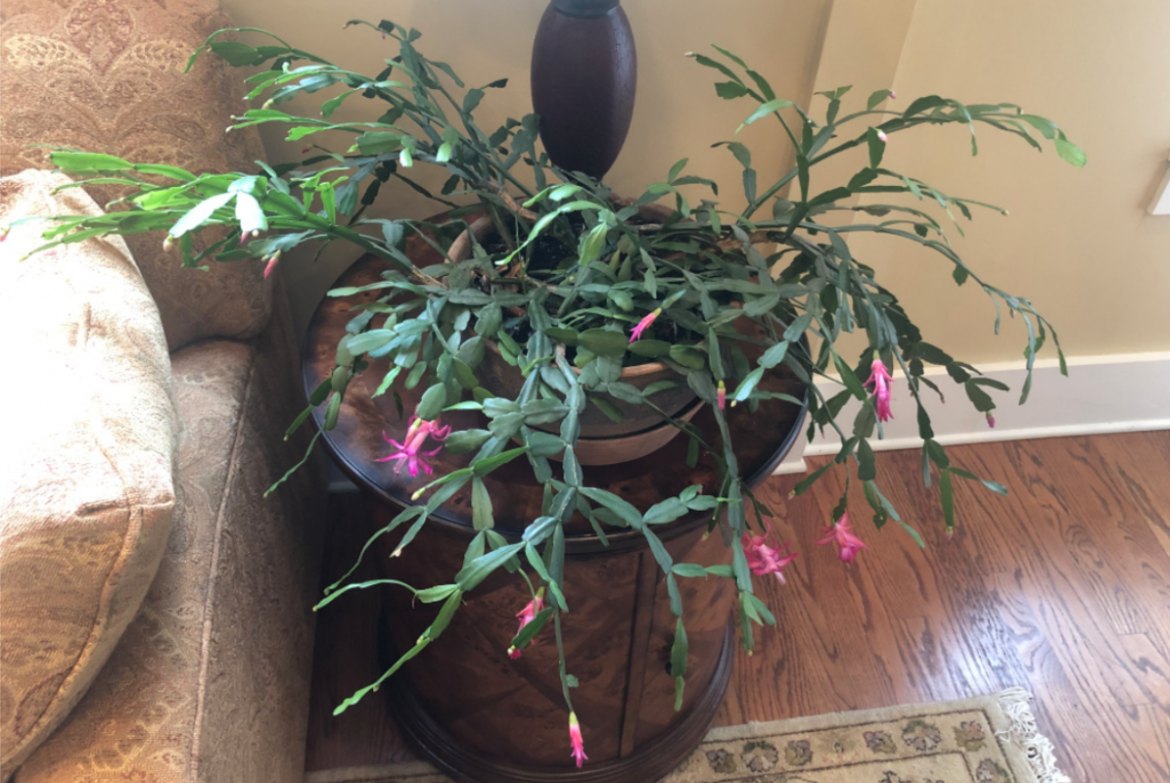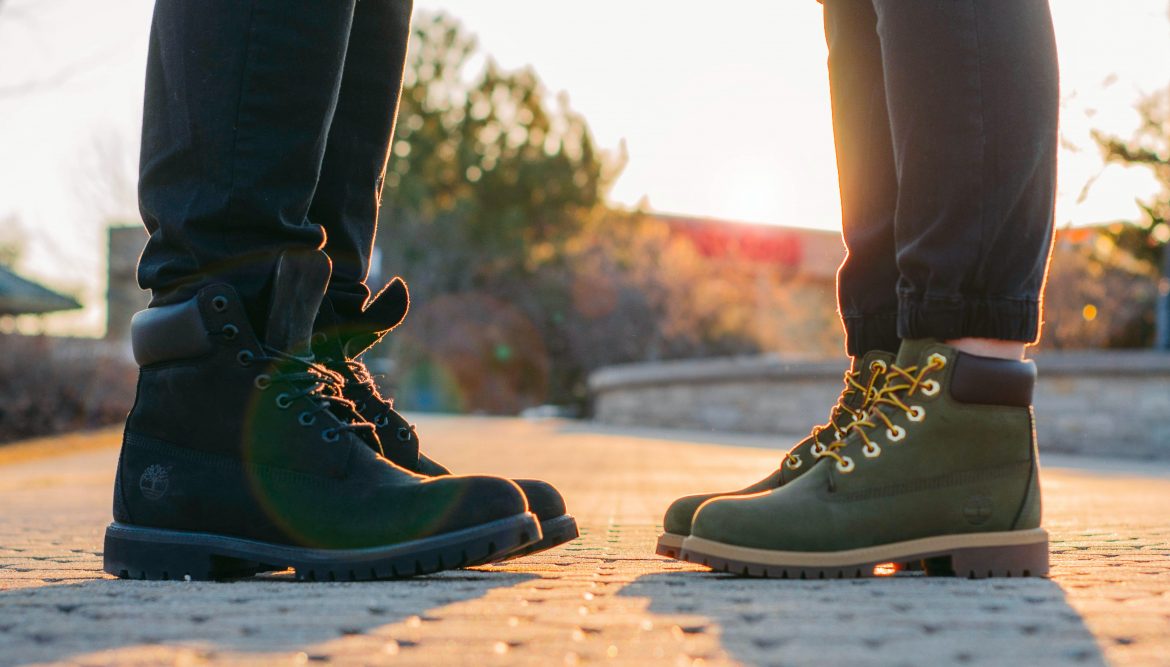I so appreciate these beautiful contemplative services from St Andrews Episcopal Church in Seattle. Here is the contemplative service with music in the style-of-Taize for Epiphany 3 with Carrie Grace Littauer as prayer leader, and music by Kester Limner and Andy Myers. Enjoy
by Diane Woodrow, photo credit: visitwales.com
On 25th January many people in Wales will be celebrating Saint Dwynwen’s Day. This is the time for marriage proposals and, at least pre-covid, of romantic meals out. From little independent card makers to big supermarkets, St Dwynwen cards are being sold. She is the Welsh equivalent of St Valentine. But why?
The little that is known about Dwynwen is that in the 5th century she was betrothed to a prince called Maelon, but he tried to seduce her before they were married. She cried out to God to be released from loving Maelon, which was granted, and Maelon was turned to a block of ice. Dwynwen then prayed that Maelon would be restored, she would be allowed to live a chaste life and that God would allow her to intercede on behalf of other lovers. God granted all three things. But there has been a chapel to commemorate her on the tidal island of Llanddwyn, Anglesey since around the 11th century. In the fourteenth century a renowned poet wrote asking her to help him in love situation. By the fifteenth century so many crippled and love sick people came and left offerings for Dwynwen to intercede for them that Richard Kyffin, the rector at that time, was able to build himself a fine home and live like a noble man.
Of course with Reformation, the veneration of saints was curtailed but people found other ways and by Victorian times, 14th February and St Valentine was becoming known as the time for lovers. It was in the 1960s with the rise of the fight to preserve the Welsh language and Welsh traditions that Vera Williams decided to revived St Dwynwen.
The character in the story of Dwynwen had some awesome qualities that need to be remembered. Firstly, she would not marry a man who tried to manipulate or abuse her, even though he was prince. She knew he needed higher standards than just taking what he wanted when he wanted it. Are we willing to have clear boundaries and hold on to them within our relationships? And are we willing to not try to take things just because we want them?
Secondly, she had the grace to forgive her abuser and release him from being frozen. I wonder if “as a block of ice” is a metaphor for being cold or hard hearted? Dwynwen prayed that he would be free to no longer be cold or hard of heart I believe. Are we willing to let go of those who’ve hurt us? Especially if we could just leave them as they are?
Thirdly, it was not just that she wanted to then lead a chaste life but that she was willing to help and heal others who had been hurt by love, by relationships. It was not that she wanted everyone to be single like herself, but that she wanted them to be free to truly love with no hinderances.
It is interesting, too, that crippled people came to her shrine. I wonder how often we are crippled by relationships so much so that our daily walk is hindered? How often do relationships bring us to a point where we are not free to hold ourselves up right and to walk freely? I do wonder if there is a connection between hurt and abuse in relationships and being crippled bodily. We do have to remember that our minds, hearts and bodies are interlinked not separate parts. Perhaps those who came to Dwynwen’s chapel understood this and after they had made their offering and received prayer they were healed and able to walk tall and be all they were meant to be – as Dwynwen was.
Our theme at Godspacelight for the beginning of this new year is healing. This month, I have offered us different gifts to open as we move into the New Year as a way of processing last year before we move too quickly into 2021. For many of us, turning the calendar page didn’t change much, it didn’t allow for the excitement most Januarys bring. Here in the States, we’ve had a rocky start with skyrocketing covid numbers, 400,000 deaths due to the pandemic, and a major attack on democracy. Thankfully, a new President was inaugurated this week. I know not everyone was happy about that, but for me, it ended four years without a plan, without empathy, and four years with a leader who lacked compassion. I realized just how depressed I have been due to all the chaos and conflict.
The night before the inauguration, we were invited to remember the 400,000 friends, family and neighbors who have died this year due to Covid-19. The Washington Mall was filled with flags and lights and music helped us reflect and remember.
We cannot heal if we don’t take time to process our sorrow and all the grief we have felt this past year. Today, I invite you to open the gift of grief.
The Gift of Grief.
Most of us need to stop and grieve the losses of 2020 and now 2021, too.
Loss of friends and family
Loss due to death
Loss due to lack of travel
Loss due to lock down and pandemic safety measures
Loss of rhythms and traditions and ways we’ve loved before
Loss of rhythms of work and school
Loss of jobs themselves
Loss of innocence when it comes to how we see ourselves
How we see our country
How we see even the church
We no longer can hide our eyes
We now understand the brokenness around us.
We have the invitation to remember
We have an invitation to pause in these days ahead… some of us in lock down again
Some of us trying way too hard to be normal…
It doesn’t really work for me to be normal this year.
There is a glaze of sadness… covering the day to day.
I’m choosing to open the gift of grief even though it’s painful. Even though I hate crying and I’m not good at grieving.
Jesus says that we will be blessed as we mourn.
Jesus knows all the sadness and all the pain we are feeling today and all the grief and trauma we’ve experienced in recent months.
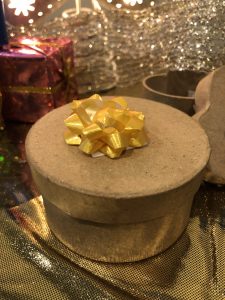
Today I choose to open the gift.
One way I have opened the gift of grief and started to heal is through art. I have prayed through my sketching with crayons and with paint.
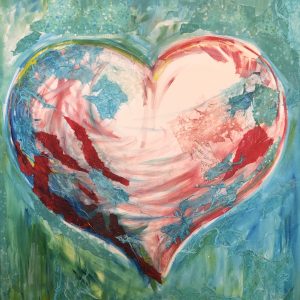
HEART collage 2020
We all need to acknowledge the heartbreak we are feeling right now so we can let Love heal us.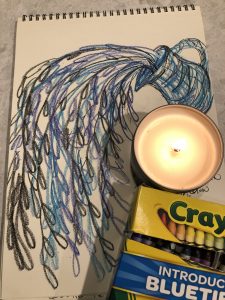
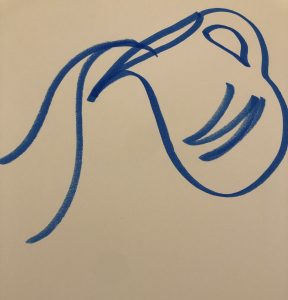
What do you need to pour out to God?
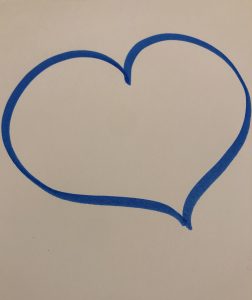
Draw the Outline of a Heart
What’s in your heart today?
by Kathie Hempel, photo by Bernie Lee, June 2020
My middle son died July 5, 2020. It was a mere two weeks before our move back to Canada. He died alone, collapsed by a heart attack in a British Columbia hospital. Bernie was supposed to be coming home to Ontario to be with his family again at Christmas. That did not happen.
I had been awaiting a call saying he was in jail or had died from his 40-year addiction for every one of those years. The heart, it seems, can break many times.
I prayed for Bernie’s healing. It did not happen. He was funny and oh so talented as an artist, musician, and poet. He oozed potential and believed in God, but what he termed “his darkness” continually overtook him.
Still, we were surprised our best laid plans were not to be. He seemed invincible. He was not. Bernie lived his life by self-propulsion, and he died the same way.
How does a mother heal from the death of a child? How does one heal the need to constantly be listening for that call? How do you heal a broken heart?
Luke 18:27 (TPT) tells us: “what is humanly impossible is more than possible with God. For God can do what man cannot.” I have trusted God in this. How can I not? I have too much evidence in my own life that testifies to his goodness. Why God did not heal Bernie is not a question I have asked. Sadly, I, like so many other mothers, fathers, grandparents, and siblings have learned God does not always say yes. God gave Bernie, who eventually contracted HIV then AIDS and Hep C, a lot more time than he statistically should have had. He repaired his relationship with us all. He comprehended that we loved him. Those were huge blessings.
I once more turned to the source of all strength and healing. As friends took over a move I could not comprehend getting through and poured me into the truck to make the move, so soon after his death, I saw God working to ease my grief interruptus. As we crossed into Canada, I experienced the kindness of strangers, who made the process much easier than it might have been. As we walked into our new apartment prepared by my eldest son, as my youngest travelled to British Columbia to gather his brother’s ashes and beloved dog, I saw the determined, reflective love of God, as we all continued the journey through grief.
My husband, though not Bernie’s father, grieved with us and removed obstacles for me to have the quiet time I needed. He read and studied God’s Word with me and apart from me. Phil did those little acts of service like cooking meals, doing dishes, vacuuming, dusting, and helping with laundry, as I unpacked and settled our new abode.
I had a difficult time shedding a single tear after the initial shock. It felt there was no time. I had to trust God would lead me through this. He did. Christmas was the time I would have been with my son again. As we celebrated the birth of our Lord, I burst into tears knowing his son died too.
When we lose someone we love, we no longer think of those things they did that irritated us. If we allow it, God will bring a flood of memories of the baby we held, the small boy we coached through hockey and school. We remember their laughter and how they made us laugh. God lets us see where he shone through them in their compassion for others and their love of the underdog.
Jesus says to us as he said to the man at the pool to pick up our mats and move on. When we look to Jesus, we know we will heal. We know he will show us the path forward. That he will cast out our demons, when moving forward seems like a bad break. He will sit with us in our grief and weep along side us through our wailing and gnashing of teeth.
If we, like the blind beggar, call out to Jesus, son of David the psalmist, to have pity and mercy: he will. The living God during times of our worse pain wraps our hearts with compassion until we are ready to expose them to the harshness of the world once more.
To be in a time of healing takes time. We need time to slowly live into our new reality. We need time to recognize all he has left us. We begin to come out of the abyss of the broken heart and God creates that time. The Holy Spirit whispers to us in our pain, leading us to our best next steps. He comforts us in the moments we feel another step is impossible and calls us to rest. He shows us his sun/son in the darkest of moments.
Jesus calls to us yet again. “Are you weary, carrying a heavy burden? Then come to me. I will refresh your life for I am your oasis.” (Matt 11: 28 TPT)
Check out Guidelines for a Personal Retreat available now as a download for only $4.99!
photos and text by June Friesen,
Moving is often anticipated to be a new beginning. One may have found their dream home. One may have found their dream country/state/city. Or it may be a new job or a promotion or a new degree. For some, moving may be from sickness to health, from loneliness to finding a friend, from feeling no one listens, cares or understands to finding someone who really does listen. So how is it that you and I can anticipate moving from where we find ourselves at this moment to the next and better place? Let us look at one of the struggles the Israelites encountered soon after they left Egypt. They had been looking for a place where they could just be with God and where life would not be full of punishment and bondage. But could it have been fantasy on their part without thinking and/or embracing the whole of reality? How about you and I, do we too fantasize sometimes when it comes to reality in our lives?
In Exodus 15: 22-26, we find Moses leading the Israelites on after they had crossed the Red Sea. While they were glad to be free from Egypt when they traveled three days without finding water they were having a change of heart. Finally, they found water but it was too bitter to drink. God told Moses to place a stick in the water – and then the water was sweet to drink. God also told Moses to let the people know there would be rules to follow and if they listened and obeyed, God would be with them and He would be their Healer.
So today we find ourselves walking through a wilderness –
Emptiness, barrenness, sticks, stones, thorns, fallen leaves strewn around –
Dry, cracked, parched dirt, dry creek beds, parched lakes and streams,
What is this journey going to bring but even more sorrow, pain and possible death?
Life never has been that easy from my perspective –
As I think back over my life I can remember how even as a child
I longed to experience life as many others around me –
It seemed as if they never had to work as hard as I did,
It seemed that they always had numerous, nice clothes to wear,
It seemed as if they did not have numerous rules to follow and expectations to meet,
If only… if only I could live in a family like theirs,
If only – and quite frankly, I even questioned God sometimes in my prayers –
“God, if You really love me why do You allow me to endure this life that I am having to live and to embrace?”
And as you are reading this today, maybe it is that you are experiencing many of these same feeling/thoughts,
Where is hope? Where is healing? When is Covid going to end?
And I am reminded of the words from Hebrews 13 where the writer assures us
That God is always with us; He will never leave us alone.
As I have been hiking through various landscapes here in the state of Arizona during these months of Covid,
I have seen the brokenness of nature –
Some of it is natural/seasonal; some of it is due to the drought that we are experiencing,
Yet for much and most of nature, it seems as if there is a rest present –
An awaiting for new life, waiting for healing from the dryness that is present –
And as it is waiting it continues to provide as simply as it can the purpose at hand –
Even if when it used to be shade it is now stability and/or a home for birds/animals –
Waiting for that moment of refreshed healing by the rain waters from above when life will once again gain new fullness.
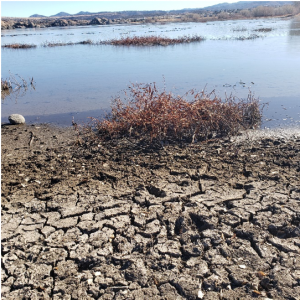
As I have been sitting the last few months I too have wondered when I have not been able to continue ministry work as I was used to –
Will my usefulness all fade and die with this pandemic?
People are still in need due to brokenness of spirit, health, emotions and for some death –
We have telephones, mail, email, computers, tablets and Zoom,
And so I began to reach out through these avenues and have found
There is healing, restoration, encouragement, hope and courage
Fostered in so many different ways –
There is healing that has been realized,
There have been new relationships formed.
Today, I do not know what you are facing, if discouraged or encouraged,
I do not know what avenues you have found for healing or restoration,
Maybe you are or have become one who shares healing or restoration –
As each one of us embraces our own admission of need –
May we embrace the gifts that God has given to us at this time –
May each one of us embrace the gift given by God to the Israelites through Moses:
“I am God, your Healer.”
Amen.
Hebrews 13: 5-6: Don’t be obsessed with getting more material things. Be relaxed with what you have. Since God assured us, “I’ll never let you down, never walk off and leave you,” we can boldly quote,
God is there, ready to help;
I’m fearless no matter what.
Who or what can get to me?
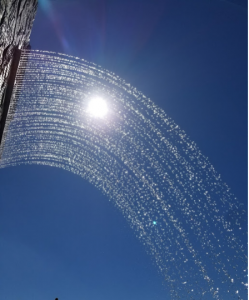
Check out Guidelines for a Personal Retreat available now as a download for only $4.99!
Photo above by Michael Moore: This Christmas Cactus began life as a cutting (from an even older plant) that Denise’s Mom was given in 1960 or 1961.
The time has come, the calendar has been turned, a new year is upon us. I don’t know about you, but I found myself entering into this new year somewhat apprehensively. I have been reviewing some of my posts from 2020 and many of them spoke to me of hope in the middle of a year which made a rather abrupt change in mid-March. I remember in the early days of COVID-19 being hopeful that we would be back in the sanctuary by Pentecost. Pentecost came and went while the only in-person worship services I led at Presbyterian Community Church of the Rockies in Estes Park, Colorado and Carrollton Presbyterian Church in Carrollton, Georgia (we left Colorado in August and began the new call on September 1st) were outdoor worship gatherings. The church continues to wrestle with this new way of being a community of faith during a pandemic. Re-imagining what worship, fellowship, prayer and study meetings look like during the pandemic continues to be a challenge for so many, including this Padre.
As this journey continues, what are we looking for in this new year? Perhaps the widespread immunization against COVID-19 across our community, state, nation, and world? Perhaps we are looking for Congress and the White House to work together for the common good of our nation and world? Perhaps we are hopeful that relationships which have been battered and bruised by toxic conversations can be restored? The optimist within says that it is possible. The pessimist within is filled with doubt. In the midst of this brokenness, my prayer is for wholeness and healing.
The lesson being taught to me by our Christmas Cactus is a message filled with hope and healing. When we lived in Florida, a friend of ours re-potted the cactus which hadn’t bloomed in four years or so. She re-potted it just before we left Florida to move to Colorado in late August, 2015. We both were worried about how the cactus would fare moving across the country and being at a much higher elevation. That Christmas, from its perch on the corner of the desk in our condo, it bloomed! The re-potting and amount of sunlight that it had were a part of the healing process for it. Moving across the country and down to a much lower elevation in August didn’t appear to make a difference. It is blooming like crazy as it sits on a table in my office at church until we decide where it will live in our house here in Georgia. The inspiration that this offers me is both hopeful and healing. The cactus lives in the present moment and invites us to do the same.
In his book, Conjectures of a Guilty Bystander, Thomas Merton said the following: You do not need to know precisely what is happening, or exactly where it is all going. What you need is to recognize the possibilities and challenges offered by the present moment, and to embrace them with courage, faith, and hope. (p. 188) Embracing the challenges and possibilities of the new year? That could considered a rather big order to fill. Merton wrote these words in the mid-1960’s and the book was first published in 1966. The war in Vietnam was raging, civil unrest and protests against the war and in support of Civil Rights and equal opportunity were on-going. In the midst of the unrest, Merton penned these words and offered that hope.
Dear reader, as we enter into 2021, may we do so with courage, faith, and hope.
Check out the post by Laurie Klein that was also posted today called “A Bowl, A Towel, A Nation”.
Also, take a look at Guidelines for a Personal Retreat available now as a download for only $4.99!
Note: As an Amazon Affiliate, I earn an amount on qualifying purchases. Thank you for your support for Godspace in this way.
by Laurie Klein
Overheated, parched, I beelined for the mini-fridge. The small unit hunkered on the motel floor, humming to itself. Cool water waited within. But the door’s rubbery seal resisted my tug. Impatient, I yanked, and the door rammed my toe, snapping a bone.
Ice, elevation, and time helped the bone reknit, but weird physical aftershocks emerged. Imagine someone dousing your foot with gasoline, then striking a match: searing nerve pain. Paradoxically icy to the touch, the little piggy that “stayed home” turned blue-black. As if it were dying. The chafe of a sock, the clinch of a shoe, the weight of a sheet draped over my foot—formerly mild sensations overshot 10 on the pain scale. My eventual diagnosis revealed a chronic pain syndrome once common among Civil War soldiers.
Besieged, the nervous system short-circuits. Each time the pain signal misfires, the resulting communications skew the body’s truth. Tissues, nerves, and mind war against one another. The wounded limb, in actuality mended, acts broken as the brain pumps out urgent protests: “Danger! Must Protect!”
Radicalized, reactionary, the extremity behaves as if mortally wounded.
And I felt betrayed by each lie. I wanted to divorce my foot, compel its secession from my body.
Medical intervention helped. Part of rehab included incrementally chafing my foot with a towel, gradually learning to override the fiery, involuntary reflex to avert touch.
I also pored over the scriptures, highlighting upbeat references to feet. Friends, they abound! Yet no verse moves me more than the passage in John where Jesus, basin in hand, towel girding his waist, washes then dries the feet of his friends.
“Now that I your Lord and Teacher have washed your feet, I have set you an example that you should do as I have done for you” (John 13:14, 15).
I don’t know where you stand on the January 6th siege at the US capitol. But I believe many of us who follow Jesus lament the incendiary, ever-widening rift dividing His followers. Will we, by our actions and rhetoric, secede from our precious unity achieved at the cost of His life?
Do we presume faith’s power and effectiveness depend on a majority consensus?
Is the Lord of Lords now so impotent that revolutionaries must save the day?
It’s all too tempting to speak and to act based on fear, rage, a desire for payback. Flaming, unchecked resolve is a steel-toed boot etching fresh battle lines in the common dust. Within our churches. Within our own families.
“My friends, these things ought not to be” (James 3:10).
Rather than being reactionary, tempted to extremes as my sickened body once was, please, let us instead be responsive. Let us be conformed, by grace, to our Savior’s example. The bowl and towel await us. Along with the living water.
After patting dry twenty-four road-weary feet—including those of Judas—Jesus said, “A new command I give you: Love one another. As I have loved you, so you must love one another. By this all will know that you are my disciples, if you love one another.”
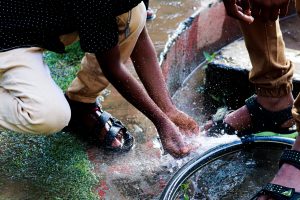
by Syed Ali on Unsplash
In these perilous days leading up to the inauguration, and beyond, may we, as the cherished body of Christ on earth—His hands and feet—first seek the cleansing, healing touch of God. Then, seeking a more perfect union with one another, may we freshly embody our love for Jesus, who prepared for the ultimate confrontation by washing the feet of those around him—including the one who betrayed him.
***
In 1936, amid the raveling times spanning two world wars, John Baillie published this prayer:
“Hasten the day when Thy presence and the strong hand of Thy purpose shall be found not only in the hearts of a few wise and brave . . . but throughout the broad land, in court and council-chamber, in workshop and market-place, in the city and in the fields. And whatever I myself can do, give me grace this day to begin; through Jesus Christ. Amen.”
—John Baillie, A Diary of Private Prayer, p. 69.
Check out Guidelines for a Personal Retreat available now as a download for only $4.99!
Note: As an Amazon Affiliate, I earn an amount on qualifying purchases. Thank you for your support for Godspace in this way.
As an Amazon Associate, I receive a small amount for purchases made through appropriate links.
Thank you for supporting Godspace in this way.
When referencing or quoting Godspace Light, please be sure to include the Author (Christine Sine unless otherwise noted), the Title of the article or resource, the Source link where appropriate, and ©Godspacelight.com. Thank you!

